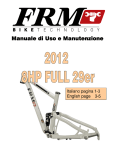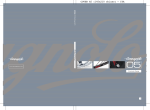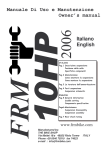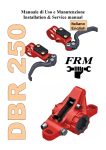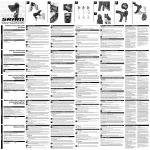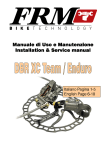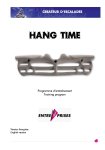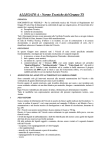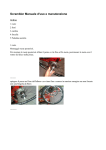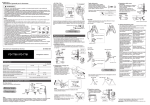Download Manuale uso e manutenzione Anakin Full
Transcript
Manuale di Uso e Manutenzione Owner’s Manual Italiano English www.frmbike.com Manufactured and distributed by: FRM Bike Technology Via Mattei 18/a 48025 Riolo Terme (Ra) ITALY Phone +39 0546 70310 fax 74623 e-mail [email protected] ITALIANO Congratulazioni Congratulazioni per aver scelto la FRM ANAKIN FULL.. E’ una MTB estremamente sofisticata che richiede cura ed attenzione. E’ assolutamente necessario leggere questo manuale prima di montare o usare la bici. Il telaio è utilizzabile esclusivamente per il Cross Country. Qualsiasi altro uso improprio limita la responsabilità del costruttore. Per ottenere le migliori migliori prestazioni, il telaio deve essere ass assemblato con componenti idonei. Si raccomanda di seguire le seguenti istruzioni. FORCELLA: Il tubo di sterzo accetta cannotti conici 1,5” - 1 1/8”. La corsa consigliata è di 100mm. Non montare forcelle a doppia piastra. MOVIMENTO CENTRALE: La scatola movimento è di tipo Press-Fit Shimano. Diametro interno 41mm. Larghezza 89,5mm, simmetrica. CORONE GUARNITURA: Disegnata per guarniture singole o doppie. Controllare che la linea catena sia quella specificata dal produttore della guarnitura DERAGLIATORE: Se necessario, utilizzare deragliatori di tipo Direct-Mount S3 per corone 36 denti, con tiro dal basso GUAINE COMANDI : I comandi del cambio e dell’eventuale deragliatore sono interni. Le loro guaine partono dai relativi comandi, si interrompono agli stop guaina a lato del tubo obliquo. I cavi escono dalla asola presente nella nicchia sottoscatola. Il tubo del freno idraulico entra nel foro sul lato del tubo obliquo ed esce dalla stessa asola nella nicchia sottoscatola. Cavi comando e tubo freno idraulico passano attraverso un apposito stop triplo in plastica, dal quale partono poi i tratti di guaina per il cambio posteriore e per l’eventuale deragliatore FRENI : Il supporto per il freno a disco è di tipo Post-Mount per dischi da 160mm, posizionato all’interno dei foderi orizzontali e verticali REGGISELLA : Il diametro del reggisella è di 31,6 mm. Scegliere il reggisella in modo che almeno 80mm ne rimangano all’interno del telaio. MANUTENZIONE Non lavare mai la bici con prodotti o solventi derivati dal petrolio (benzina, petrolio, nafta ecc) che sciolgono il grasso dei mozzi, movimento centrale e sterzo, ma solo con detergenti o saponi ad acqua. Dopo il lavaggio, asciugare e ungere catena, pedali, movimento e deragliatori con oli specifici. MANUTENZIONE Si richiede una manutenzione simile a quella riservata ad altri telai da MTB. Prima di ogni uscita Controllare la forcella anteriore. Controllare il serraggio dell’attacco manubrio e del manubrio. Controllare il gioco dello sterzo. Controllare la tensione degli sganci. Controllare il funzionamento dei freni e l’usura dei pattini. Controllare il funzionamento di cambio e deragliatore. Controllare la pressione delle gomme. Controllare che le ruote siano centrate Ogni 33-6 mesi Sostituire l’olio della forcella. Smontare, pulire e ingrassare lo sterzo ed il movimento centrale. Smontare, pulire ed ingrassare i mozzi. Sostituire guaine e cavi del cambio, deragliatore e freni. Smontare, pulire ed ingrassare gli snodi della sospensione. SMONTARE LA SOSPENSIONE ATTREZZI NECESSARI: NECESSARI: chiave a brugola da 3mm due chiavi a brugola da 6mm 1 Sfilare i perni dell’occhio superiore ed inferiore ammortizzatore dopo aver svitato le viti a brugola conica con chiave da 3mm. 2 Smontare l’ammortizzatore dal telaio 3 Separare il braccio superiore sospensione dalla biella svitando i due bulloni di fissaggio con due chiavi contrapposte a brugola da 6mm. Sfilati i bulloni si separa dalla biella un tubo distanziale di irrigidimento. Attenzione alle rondelle distanziali ed agli O-Ring che si trovano tra la biella e le estremità della sospensione. 4 Controllare i movimenti sia della biella che della sospensione sul telaio. Devono essere fluidi, omogenei e senza alcun gioco. 5 Separare la sospensione dal telaio svitando i due bulloni di fissaggio con due chiavi contrapposte a brugola da 6mm. Attenzione alle rondelle distanziali ed agli O-Ring che si trovano tra il telaio e le estremità della sospensione. 6 Separare la biella dal telaio svitando i due bulloni di fissaggio con due chiavi contrapposte a brugola da 6mm. Attenzione alle rondelle distanziali ed agli ORing che si trovano tra il telaio e la biella. 7 Se necessario, smontare i cuscinetti dalle loro sedi e sostituirli con nuovi di tipo MAX a pieno riempimento di sfere (Full Complement Balls) MONTARE LA SOSPENSIONE ATTREZZI NECESSARI: chiave a brugola da 3mm due chiavi a brugola da 6mm frenafiletti medio grasso idrorepellente da cuscinetti 1 Ingrassare i sei cuscinetti su ambedue le loro facce. 2 Bagnare con un paio di gocce di frenafiletti medio il filetto dei sei bulloni di alluminio e delle due viti in acciaio a testa conica 3 Posizionare la parte bassa della sospensione in corrispondenza del perno filettato del telaio, interponendo tra cuscinetti e telaio una rondella + O-Ring per lato. Infilare due bulloni (corti) con il loro O-Ring ed avvitarli con due chiavi a brugola da 6mm contrapposte. Serrare a 10Nm 4 Verificare che il movimento braccio della sospensione sia fluido, omogeneo e senza giochi 5 Posizionare i fori alti della biella in corrispondenza del perno filettato del telaio, interponendo tra cuscinetti e telaio una rondella + O-Ring per lato. Infilare due bulloni (corti) con il loro O-Ring ed avvitarli con due chiavi a brugola da 6mm contrapposte. Serrare a 10Nm 6 Verificare che il movimento della biella sia fluido, omogeneo e senza giochi 7 Posizionare la parte alta della sospensione in corrispondenza dei fori bassi della biella, interponendo tra cuscinetti e biella una rondella + O-Ring per lato. Inserire all’interno della biella il tubo distanziale in alluminio filettato. Infilare due bulloni (lunghi) con il loro O-Ring ed avvitarli al tubo distanziale con due chiavi a brugola da 6mm contrapposte. Serrare a 10Nm 8 Verificare che il movimento della sospensione sia fluido, omogeneo e senza giochi 9 Inserire l’ammortizzatore infilando i relativi perni di fissaggio: quello lungo nell’occhio superiore e quello corto nell’occhio inferiore tra ammortizzatore e biella 10 Infilare le viti a testa svasata M5x10 nelle relative rondelle coniche ed avvitarle nei perni di fissaggio con chiave a brugola da 3mm. Serrate a 5Nm TARARE L’AMMORTIZZATORE Interasse ammortizzatore 165mm SAG La pressione dell’aria, immessa con una pompa dotata di valvola Shraeder, determina il sag (affondamento) che si determina con il ciclista, in ordine di marcia, seduto in sella . Si consiglia un sag di 88-9 mm. mm. Un O-Ring filato sullo stelo dell’ammortizzatore aiuta a calcolare questa distanza Attenzione Attenzione: l’ammortizzatore non deve comprimersi per più di 12mm 12mm con il peso del ciclista in sella. Oltre questo limite è molto facile raggiungere il fondocorsa con conseguenti problemi strutturali dell’ammortizzatore e/o del telaio. La corsa totale dell’ammortizzatore è di 37mm, per una corsa alla ruota di 100mm PROCEDURA PER CALIBRARE LA PRESSIONE DELL’ARIA Immettere aria nella valvola con una pompa ad alta pressione dotata di valvola Shraeder. Far scivolare l’O-Ring sullo stelo dell’ammortizzatore completamente verso l’alto. Salire in sella appoggiando le mani sul manubrio, nella posizione della pedalata.. Scendere lentamente dalla bici e misurare lo spostamento dell’O-Ring sullo stelo, ovvero la distanza tra l’O-Ring e il paraolio. Se l’ammortizzatore affonda troppo occorre ripetere l’operazione dopo aver aumentato leggermente la pressione. Se, al contrario, l’ammortizzatore non affonda a sufficienza, occorre sgonfiarlo leggermente. Dopo un certo numero di prove sarà evidente a quale pressione si deve gonfiare l’ammortizzatore perché il sag sia quello giusto. E’ evidente che chi utilizza la bici per puro escursionismo cercherà il massimo del confort e probabilmente utilizzerà una pressione inferiore a quella in tabella, che permetta di raggiungere un sag di 8 - 9 mm, mentre gli agonisti, che prediligono la prestazione, possono aumentare la pressione in modo da ottenere un sag inferiore. La possibilità di bloccare l’ammortizzatore nei momenti di rilancio della velocità offre comunque la possibilità di mantenere la pressione a livelli normali. L’O-Ring infilato sullo stelo dell’ammortizzatore permette anche di controllare la corsa massima raggiunta dopo una discesa. Nel caso in cui, per particolari stili di guida, non si riesca mai a sfruttare tutta al corsa dell’ammortizzatore sarà bene diminuire la pressione. Il contrario ovviamente se, per una guida particolarmente aggressiva si raggiunge troppo frequentemente il fondocorsa. PROCEDURA PER CALIBRARE LA VELOCITA’ DI RITORNO Vedi istruzioni dello specifico ammortizzatore montato sul telaio BLOCCO DELLA SOSPENSIONE Vedi istruzioni dello specifico ammortizzatore montato sul telaio MANUTENZIONE L’ammortizzatore va lavato e pulito dopo uscite particolarmente sporche. Il fango che si secca sullo stelo può infatti danneggiare le tenute idrauliche. Durante il lavaggio accertarsi che il tappo di protezione della valvola dell’aria sia avvitato. Non è prevista la sostituzione dell’olio all’interno dell’ammortizzatore se non nel caso in cui questo presenti dei problemi di funzionamento. Lo smontaggio dell’ammortizzatore va eseguito solo da centri specializzati col permesso del produttore. La garanzia decade automaticamente nel caso in cui si smonti l’ammortizzatore senza autorizzazione. GARANZIA I prodotti FRM sono garantiti contro difetti di materiale e costruzione per un periodo di 2 anni dalla data di acquisto del primo utilizzatore, certificata dallo scontrino fiscale del negozio. La garanzia decade nel caso in cui la manutenzione ordinaria o straordinaria consigliata in questo manuale non sia stata eseguita OBBLIGHI: in caso di vizio, FRM si impegna ad effettuare la sostituzione o la riparazione, a sua discrezione dell’elemento riconosciuto difettoso. Per essere accettato, il difetto deve essere comunicato dal legittimo proprietario al negoziante dove il prodotto è stato acquistato e da quest’ultimo, dopo averlo verificato, alla FRM Nel caso in cui la FRM non riconosca l’esistenza del difetto o stabilisca che questo è dovuto ad una delle cause riportate nel seguente paragrafo, la sostituzione non è dovuta ed il componente viene restituito a spese del destinatario LIMITI: la garanzia non copre i danni risultanti da trasporto, giacenza, incidenti, negligenze, colpi o cadute, mancato rispetto delle informazioni del libretto istruzioni, montaggio errato o con prodotti non compatibili, cattiva manutenzione, usura normale, modifiche o alterazioni del prodotto. La Garanzia non copre le parti soggette a normale usura (cuscinetti, paraolio ecc.) ------------------------------------------------------------------------------------------------------------------------------------------ENGLISH Thank you for making the Anakin Full frame your choice in full suspension. It is mandatory to read this manual entirely prior to working on your bike. This frame has been designed exclusively for Cross Country riding Any other improper use will void your warranty The use of double-triple crown front forks will void your warranty To obtain the best performance results, this frame must be assembled with the correct correct components. components. Please follow these instructions. FRONT FRONT FORK: FORK Head tube is for tapered 1,5” - 1 1/8” fork steerers. Suggested wheel travel is 100mm. Never install double-triple crown forks. BOTTOM BRACKET: BRACKET Shimano Press-Fit standard. Inner bore 41mm Length 89,5mm symmetric CHAINRINGS: Designed for single or double cranksets. The chainline is specified by the crankset manufacturer FRONT DERAILLEUR: DERAILLEUR: If necessary install bottom-pull Direct-Mount S3 type front derailleurs for 36t chainrings CABLES : The rear and front derailleur cable guides are internals. Their housings start from shifters to the stops on the down-tube sides. Steel wires exits from the down-tube from a oval window located in front of the bb shell. The rear brake housing is internal as well. As a single continuous unit inside the down-tube, it exits form the same window under the frame. Derailleur wires and hydraulic housing run through a plastic triple plug to their final destinations BRAKES : Post-Mount disc support for 160mm disc rotors SEATPOST : Seat-post diameter is 31,6 mm. Make sure that there is at least 80 mm of seat-post tube inside the frame MAINTENANCE Never clean the bike with petroleum-based products or solvents (petrol, gasoline, diesel, etc.) as they will dissolve the grease in the bearings. After washing, wait until the bike is dry, then lubricate the chain, pedals, bottom bracket, hubs and derailleurs. MAINTENANCE This frame requires a maintenance regime similar to that of any type of MTB. Before every ride Check the front fork. Check bolt tension of the stem. Check headset play. Check tension of quick releases. Check brake efficiency. Check front and rear derailleur efficiency. Check tire pressure. Check wheel trueness Every 33-6 months Replace fork oil Disassemble, clean and grease the headset, and bottom bracket Disassemble, clean and grease the front and rear hubs. Replace derailleur and brake cable guides. Disassemble, clean and grease all suspension pivot points. Allen keys. Tighten at 10Nm 4 Check that the suspension strut turns freely and smoothly without play. 5 Align the upper ends of the rocker-arm with the threaded frame stud located in the top tube. Insert two aluminium washers + O-Rings between the frame stud and both ends of the rocker-arm. Slide two short bolts with their O-Rings into the bearing bores and screw them with two opposed 6mm Allen keys. Tighten at 10Nm 6 Check that the rocker-arm turns freely and smoothly without play. 7 Align the upper ends of the suspension strut with the rocker-arm lower ends. Insert two aluminium washers and O-Rings between the rocker-arm and both ends of the suspension strut. Position the stiffening threaded tube inside the wings of the rocker-arm. Slide two bolts (long) with their O-Rings into the bearing bores and screw them with two opposed 6mm Allen keys. Tighten at 10Nm 8 Check that the suspension and rocker-arm turn freely and smoothly without play. 9 Position the shock into its seats and slide the long axle into the upper eye and the short axle into the lower eye 10 Slide the M5 cone-headed bolts into their conical washers and screw them into the shock axles with a 3mm Allen key. Tighten at 5Nm SUSPENSION DISASSEMBLY REAR SHOCK TUNING TOOLS: Required rear shock length: 165mm SAG One 3mm Allen key Two 6mm Allen keys 1 With the 3mm Allen key unscrew the cone-headed bolts at the upper and lower ends of the shock and slide both axles out of the shock eyes 2 Disassemble the shock from the frame. 3 With two 6mm Allen keys unscrew the bolts at the upper ends of the suspension strut. Pay attention to the washers and O-Rings which are seated between the rocker-arm and the upper ends of the suspension strut. Rocker-arm and suspension are now separated 4 Check any eventual play of both the rocker-arm and the suspension strut. It should turn freely and smoothly without play. 5 With two 6mm Allen keys unscrew the bolts at the lower ends of the suspension strut. Pay attention to the washers and O-Rings which are seated between the rocker-arm and the upper ends of the suspension strut. Frame and suspension are now separated 6 With two 6mm Allen keys unscrew the bolts at the upper ends of the rocker-arm. Pay attention to the washers and O-Rings which are seated between the rockerarm and the upper ends of the suspension strut. Frame and rocker-arm are now separated 7 If necessary, bearings can be disassembled by tapping them out of their seats with a plastic rod and mallet. Replace exclusively with MAX type bearings (Full Complement Balls) SUSPENSION ASSEMBLY TOOLS: One 3mm Allen key Two 6mm Allen keys Medium Thread Compound Water-proof bearing grease 1 Grease all bearings on both faces 2 Put a few drops of Loctite Medium compound on the thread of all bolts 3 Align the lower ends of the suspension strut with the threaded frame stud located just over the bb shell. Insert two aluminium washers and O-Rings between the frame stud and both ends of the suspension strut. Slide two bolts (short) with their O-Rings into the bearing bores and screw them with two opposed 6mm The suggested suggested sag has has been determined as 8mm. 8mm. This sag level is about 1/4 of the total shock travel. It means that the rear shock should shorten by 8mm with the cyclist sitting on the saddle. Warning Warning: rning: a sag higher than 1111-12mm 12mm is detrimental to the shock functional capacity. Beyond this limit it is very easy to bottom out, with negative consequences on the shock and/or frame structure. The total travel of the shock is 37mm, which translates into 100mm of wheel travel. AIR PRESSURE CALBRATION PROCEDURE Unscrew the cap of the valve (positive chamber) and inflate with a fork pump fitted with Shraeder adaptor. NOTE: NOTE if you re-attach the pump, the hose will re-fill with air. This will result in a lower PSI registering of approximately 15 to 20 PSI on the gauge. Sit on the saddle and measure the shock sag. If the shock over-sags de-pressurize the chamber and repeat the procedure to a slightly lower pressure. If the shock under-sags increase the pressure. After a few tests the correct pressure for optimum sag will become evident. It is clear that if the bike is used simply for sport, the rider should tune the suspension as confortably as possible (9-10 mm of sag) and will probably obtain the best results at pressures which are slightly lower than those of the table. The pro-racers however may prefer to sacrifice comfort for a stiffer suspension. In this case we suggest increasing the pressure until the bobbing is minimal. The low progression of the spring rate, achieved with variable volumes of the air-chamber allows up to 10% more travel available at the some pressure of a shock with constant air chamber volume. This means that you can use an higher pressure in order to avoid bobbing and nevertheless use the whole travel of the shock if needed. REBOUND DAMPING CALIBRATION PROCEDURE Read the manual of the shock which has been installed on the frame LOCKLOCK-OUT Read the manual of the shock which has been installed on the frame MAINTENANCE The shock should be washed and cleaned after wet and muddy rides. Mud drying on the stanchions can in fact damage the seals. During washing make sure that the air-valve cap is securely in place. The oil inside the shock need not be replaced unless there are functional difficulties. The shock-unit should only be disassembled by specialists authorized by the manufacturer. The guarantee will be void if the shock-unit is disassembled without prior authorisation WARRANTY FRM products are guaranteed against any defects for a period of 2 years from the date of purchase by the first owner, registered in a dealer shop. OBLIGATIONS: In case of defects, FRM pledge to replace or repair, at their discretion, the part recognised as defective. To be accepted, the rider compliant must be communicated to FRM through the dealer/importer after his own control. If FRM after sales checking reveals that the damage is due to one of the reasons mentioned in the following paragraph, the replacement is no longer accepted and the defective item is sent back to the plaintiff who supports the shipping fees. LIMITATIONS: The guarantee does not cover damage resulting from transportation, warehousing, accidents, negligence, impact or falls, non-compliance with the information in the instruction manuals, assembly errors, assembly using non-compatible products, bad maintenance, modifications or alterations to the product. The guarantee does not cover parts and components subject to normal wear and tear such as ball-bearings, bushings, seals, etc.




